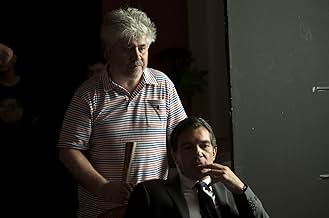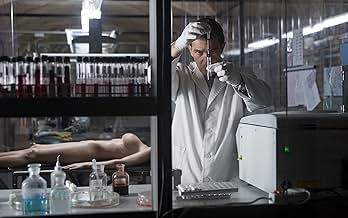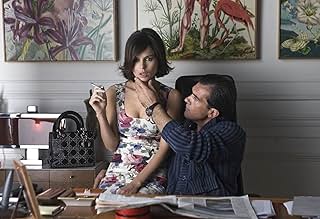La piel que habito
Un brillant chirurgien esthétique, hanté par des tragédies passées, créé une peau synthétique capable de supporter tout type de dommage. Son cobaye? une femme mystérieuse et instable qui dét... Tout lireUn brillant chirurgien esthétique, hanté par des tragédies passées, créé une peau synthétique capable de supporter tout type de dommage. Son cobaye? une femme mystérieuse et instable qui détient la clé de son obsession.Un brillant chirurgien esthétique, hanté par des tragédies passées, créé une peau synthétique capable de supporter tout type de dommage. Son cobaye? une femme mystérieuse et instable qui détient la clé de son obsession.
- Réalisation
- Scénario
- Casting principal
- Victoire aux 1 BAFTA Award
- 28 victoires et 69 nominations au total
Avis à la une
Antonio Banderas is so terrific as the leading man, he hasn't looked this great in screen in a long time, I think he seems more at home in his native language, and Elena Anaya is absolutely radiant on the big screen, her face just lights up the screen and she is absolutely exceptional in a very strange role. The story is really a bizarre one, it's seems like a less perverted De Sade and a more understandable David Lynch, it always takes you by surprise and it is highly original and also somewhat daring I think, and thank god a director like Almodovar decided to film it and not some silly director.
The cinematography and music is beautiful, the colours and textures in the film are picked up beautifully by the camera and the music is a great companion to each scene, it's so close to perfection in the production design department that i would go so far to say as I haven't seen a better looking film this year.
This movie is in my opinion the least accessible of all of Almodovar's films but I hope it doesn't put people off, as his touch and style is clear and present here. It's very different, strange, perverted, horrific, beautiful and always entertaining.
Enjoy :)
With that in mind, I'll keep this review short and will try not to give anything away. Antonio Banderas plays a rather unhinged scientist who is keeping a beautiful young woman prisoner in his home while using her as a human guinea pig for a new type of synthetic human skin. That's about as much information as you need. As the story unfolds, petal by petal in that flower-like way we've become accustomed to seeing from Almodovar, each scene adds wonder and flavour to an already robust set-up. Moving at a break-neck pace, not a frame is without beauty and not a second is wasted without pushing the story along. This screenplay is extremely polished and beautifully nuanced.
As usual, cinematographer Jose Luis Alcaine delivers beautifully vibrant visuals, but unlike other Almodovar films, this palette is decidedly less colourful, sticking mainly to Cronenbergian metallic colours fused with fleshy tones but with the odd gash of vibrant colour. It is as beautiful to behold as any other Almodovar film, but perhaps less garish.
In a film that relies on ambiguity in so many ways the cast here must be commended. Delicate balances are achieved by all concerned and it's wonderful to see Antonio Banderas settling into the rather unsettling role of Dr. Robert Ledgard. He exudes the same charisma and sexual bravura that made him famous but without the least whiff of sex symbol status coming through in the performance. He is creepy, strangely alluring and underplays the "mad scientist" bit admirably. Elena Anayas also impresses in a very challenging performance both physically and emotionally, both of which are perfectly effective as her story unfolds. A brilliant character who may not have been so impressive in the hands of a less capable actress. The camera intimately caresses her face and body throughout and she steadfastly rises to the challenge of being as beautiful a muse as a director could ask for.
It is unlikely that Almodovar will win over any new fans with The Skin I Live In but he will surely satisfy his already massive fanbase. A dark, thoughtful, frightening piece but never shying away from the heights of melodrama that Almodovar is known for, this sits beautifully on the line between Cronenberg at his best and a crazy soap opera.
Unique, Gothic and delightfully melodramatic! I love it!
http://charlenefilmblog.blogspot.com/2011/08/skin-i-live-in.html
Spanish director Pedro Almodóvar has a just reputation for taking women seriously in his films. His latest effort (as usual in Spanish with English subtitles) is no exception, even tho he gives most of the screen time to his most accomplished discovery and frequent star, Antonio Banderas (seemingly one of the few Hispanic actors whom Americans will tolerate in a lead role), playing the brilliant and innovative plastic surgeon Robert Ledgard. This is a deadly serious role, in marked contrast to Banderas's other current star turn as the voice of Puss in Boots.
The female lead, Elena Anaya, plays Vera Cruz (yes), Ledgard's stunningly gorgeous patient, experimental subject, apparent captive, and well, here Almodóvar (who co-wrote the screenplay with brother Agustín) gets a bit coy. Is she a manikin, an Eliza Doolittle to Ledgard's Henry Higgins, a Sabina Spielrein to his Carl Jung, possibly a creature to his Frankenstein? Or maybe none of the above? We know only that she seems devoted to him, tho he is unresponsive to her charms.
Vera is confined to the big bedroom, elegantly furnished, where she does her yoga exercises dressed in a flesh-colored body stocking. Ledgard has the only key to the room, and he always keeps her locked in. He himself stays in the smaller bedroom next door, where he watches her intently on a wall-sized video screen. All her food and other needs are delivered from the kitchen via a dumbwaiter, and she communicates with only 2 people: Robert in person, and the housekeeper via intercom.
Ledgard is a widower, and we see in flashback that his wife Gal suffered a terrible car accident and fire, leaving her horribly disfigured even after Robert's virtuoso surgical work and devoted care. But even after all his efforts, Gal is unable to stand her pain, weakness, and ugliness, and she commits suicide. Unfortunately, it's right in front of their tweenage dotter Norma (Blanca Suárez), who is driven into hysterics and a nervous breakdown by the sight.
Ledgard, as one of the world's leading reconstructive surgeons, does not lack for cash, so he devotes the next several years to his twin obsessions, coaxing his dotter back from the precipice of madness and developing a graftable artificial skin, which he somewhat ghoulishly dubs Gal, a combination of human and pig genes that's highly resistant to burns, cuts, and punctures. Such an epidermis would have saved his beloved wife, he reasons, and this alone justifies his transgressing the ethical boundaries against transgenics. (This is the only science-fictional element in the film, and it's not much of a stretch from what modern medicine is actually capable of doing, which is why I categorize it as essentially a psychodrama.)
There are 3 other characters of note: Ledgard's housekeeper Marilia (Marisa Paredes), an older woman with secrets of her own; her wastrel son Zeca (Roberto Álamo), who pays an unwelcome visit; and studly young Vicente (Jan Cornet), son of and apprentice to the local dressmaker, who takes a shine to now-teenage Norma as she shyly tries to work her way back into normal society.
We learn most of the above during the first half hour, which leaves us wondering just what on Earth is going on here. The remainder of the film slowly pulls aside one curtain after another to fill us in. And that is all I will say on the subject. You'll have to see the rest for yourself.
And you should.
The order in which the events of the story are told is a cunning device that allows the director to make us reflect on how superficially - indeed, skin-deep - we perceive reality and how quick we are to judge first impressions and jump to conclusions. What we first perceive one way, those initial scenes that slightly baffle us but which we nevertheless do not hesitate to judge in a specific way, take on a completely new meaning when the story pauses to take us back into the past in order to tell us about an important series of events that happened at the time which bear a direct relation to present events. The new light that is shed on the present changes completely our perception of the story as we had first witnessed it, which is a humbling experience. We are then taken back again to the present and continue watching the rest of the film, but with this completely new understanding of the real underlying motivations for the characters' actions. It is at this point that through a slight thriller-style twist in the plot the story takes on a Shakespearean dimension as it delivers its powerful humanist lesson that vengeance begets vengeance.
Food for thought, in fact enough food to last you days and feed other people, as you are left on the one hand wondering at the concept of skin: what we actually desire when we desire someone, whether all desire is skin-deep, whether the skin does not allow us to see the person behind. And on the other hand you are left with the reflection on how the road of vengeance leads only to self-destruction. When a film leaves you pondering so deeply, I can only conclude it is a great film.
Le saviez-vous
- AnecdotesAfter a few days of shooting, Pedro Almodóvar had a conversation with Antonio Banderas in which he told Banderas that he needed to drop all of his tics as an actor, because the director wanted a really restrained character and the actor was playing him in a more typical psycho way.
- GaffesWhen Doctor Robert Ledgard and his colleagues are preparing themselves for surgery, they fasten each other's surgical gown from the back, contaminating their sterile gloves.
- Citations
Profesora de Yoga en TV: There's a place where you can take refuge. A place inside you, a place to which no one else has access, a place that no one can destroy.
- Crédits fousAt the start of the end credits, there is a rotating DNA double helix in the background.
- ConnexionsFeatured in At the Movies: Cannes Film Festival 2011 (2011)
- Bandes originalesPor el amor de amar
(Versión Castellana)
Written by Jean Manzon and José Toledo
Performed by / interpretada por CONCHA BUIKA (Buika), al piano Iván González Lewis (as Iván 'Melón' Lewis)
© 1960, by Jean Manzon & Jose Toledo.
Autorizado para todo el mundo a Universal Music Publishing, S.L.
Todos los derechos reservados.
Grabado en CATA (Madrid).
Meilleurs choix
Détails
- Date de sortie
- Pays d’origine
- Sites officiels
- Langues
- Aussi connu sous le nom de
- The Skin I Live In
- Lieux de tournage
- Sociétés de production
- Voir plus de crédits d'entreprise sur IMDbPro
Box-office
- Budget
- 10 002 914 € (estimé)
- Montant brut aux États-Unis et au Canada
- 3 185 812 $US
- Week-end de sortie aux États-Unis et au Canada
- 223 119 $US
- 16 oct. 2011
- Montant brut mondial
- 33 716 389 $US
- Durée2 heures
- Couleur
- Mixage
- Rapport de forme
- 1.85 : 1
Contribuer à cette page


![Regarder Tráiler [OV]](https://m.media-amazon.com/images/M/MV5BODliMDVlYjQtN2U1OC00MGVlLWE5YWEtNDk5OTMzMGZkOGFhXkEyXkFqcGdeQXRodW1ibmFpbC1pbml0aWFsaXplcg@@._V1_QL75_UX500_CR0)




































